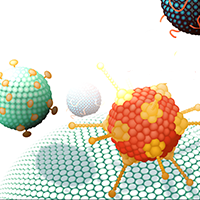The latest developments in viral and non-viral vector manufacturing
Cell Gene Therapy Insights 2018; 4(10), 1041-1042.
10.18609/cgti.2018.103
Welcome to the Cell and Gene Therapy Insights spotlight providing you with the latest updates on developments in viral and non-viral vector manufacturing.
In the Expert Insight article, Challenges and progress in lentiviral vector bioprocessing, Eugenio Macchiarulo et al. (Adaptimmune) examine technical and strategic issues spanning US and DS bioprocessing and CMC controls, and share their views on likely future trends concerning this key enabler of the burgeoning cellular immunotherapy field.
The future of lentiviral vectors is also the focal point for an Editorial from Marc Moore and John Counsell (UCL) who discuss the question of whether lentiviral vectors in hematopoietic stem cell therapies will remain a key technology, or if they are simply a bridge to gene editing approaches?
Despite the inherent advantages offered by highly efficient viral vectors, non-viral platforms continue to draw attention for their potential to address thorny issues including pre-existing antibodies and re-dosing. Suneel Narayanavari (Max Delbrück Center for Molecular Medicine/Rutgers University) examines one of the most promising non-viral approaches to emerge in recent times in his Editorial, Update on the Sleeping Beauty transposon system for therapeutic applications.
This pressing need for optimized vector production systems is driving cutting edge innovation within the gene therapy tool and service provider sector. In his Innovator Insight, Dan Farley (Oxford Biomedica) describes one such breakthrough in the form of the TRiP System™, which offers a novel approach to maximising titre during viral vector production.
In our Conference Spotlight, R. Jude Samulski et al (AskBio) share findings from a highly significant recent workshop co-organised by NCATS and the US FDA: Gene Therapy Approaches to Rare Diseases. (staged on August 20-21, 2018 in Bethesda, MD, United States).
Kicking off an extensive interviews section, Guest Editor, Jan Thirkettle (Freeline) offers his assessment of viral and non-viral technologies in development and discusses shifting trends in gene therapy manufacturing strategy which carry potentially significant repercussions for biotech and CMOs alike.
The current vector manufacturing capacity crunch is a key underlying theme which underpins much of this Spotlight. Through 2 distinct pieces of content – an interview with Phil Vanek and an infographic – leading solution provider, GE Healthcare, frames the current challenge and shares their views on future directions in technology development to alleviate this potentially significant lag on the gene therapy sector.
And staying with the enabling technology theme, Vanessa Carvalho (Vironova) explains the utility of electron microscopy-based tools for nanoparticle characterization, and their potential to drive advances in purification for the AAV vector space and beyond.
Roger Hajjar (Icahn School of Medicine at Mount Sinai) reveals ongoing research at the Cardiovascular Research Center in both AAV and exosome-based in vivo gene therapy and provides sage words of advice for the many newly entering this technology area.
Another of gene therapy’s long-standing leading lights is Fraser Wright (Axovant Therapeutics). Here, Wright reflects upon Spark Therapeutics’ successful bioprocess development of Luxturna, which he oversaw, and also looks forward to a bright future for lentiviral vector-driven in vivo approaches.
Like Spark Therapeutics, GenSight Biologics is one of relatively few AAV gene therapy companies that has experience of conducting multiple late-phase clinical trials. Krzysztof Regulski tells of manufacturing, supply chain and regulatory lessons learned through preparing for their current multinational pivotal trial.
Abeona Therapeutics is one gene therapy biotech that has taken the bold step of establishing its own GMP manufacturing facilities. CSO, Tim Miller, considers the strategic drivers behind the decision to ‘go it alone’ and the pros and cons of doing so.
We hope you enjoy this exciting collection of articles from leading experts and as always, welcome your feedback.
Affiliation
Jan Thirkettle
Chief Development Officer,
Freeline Therapeutics
